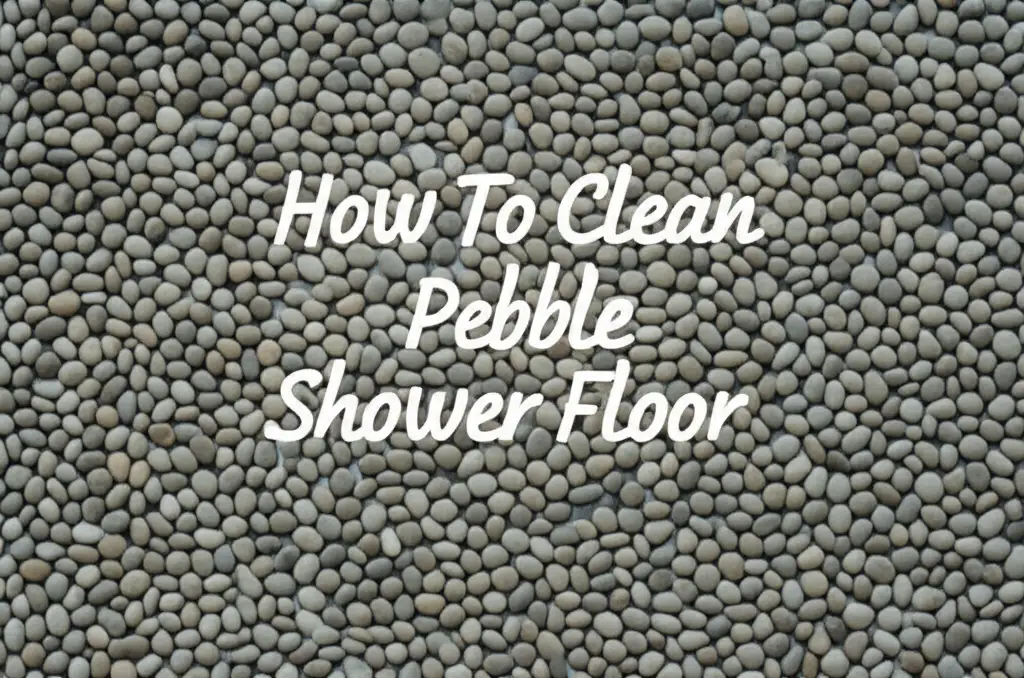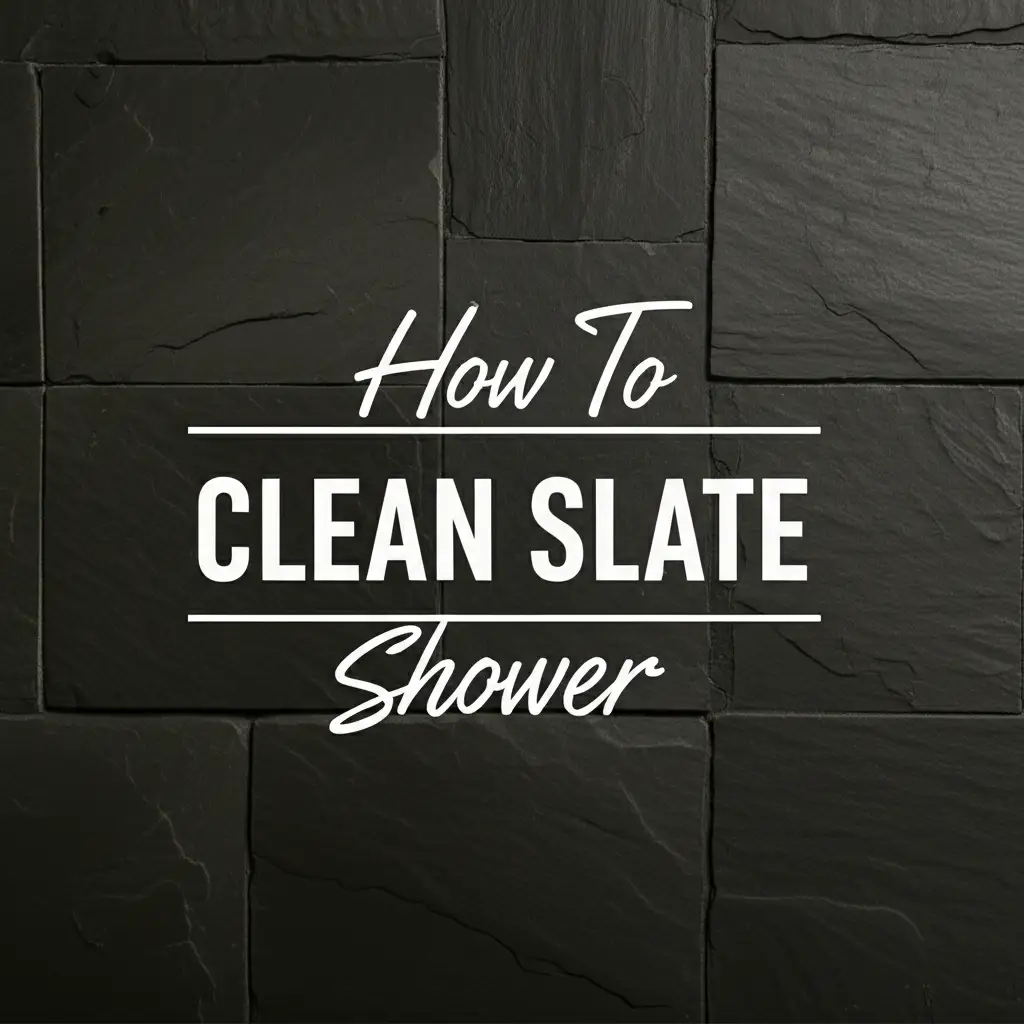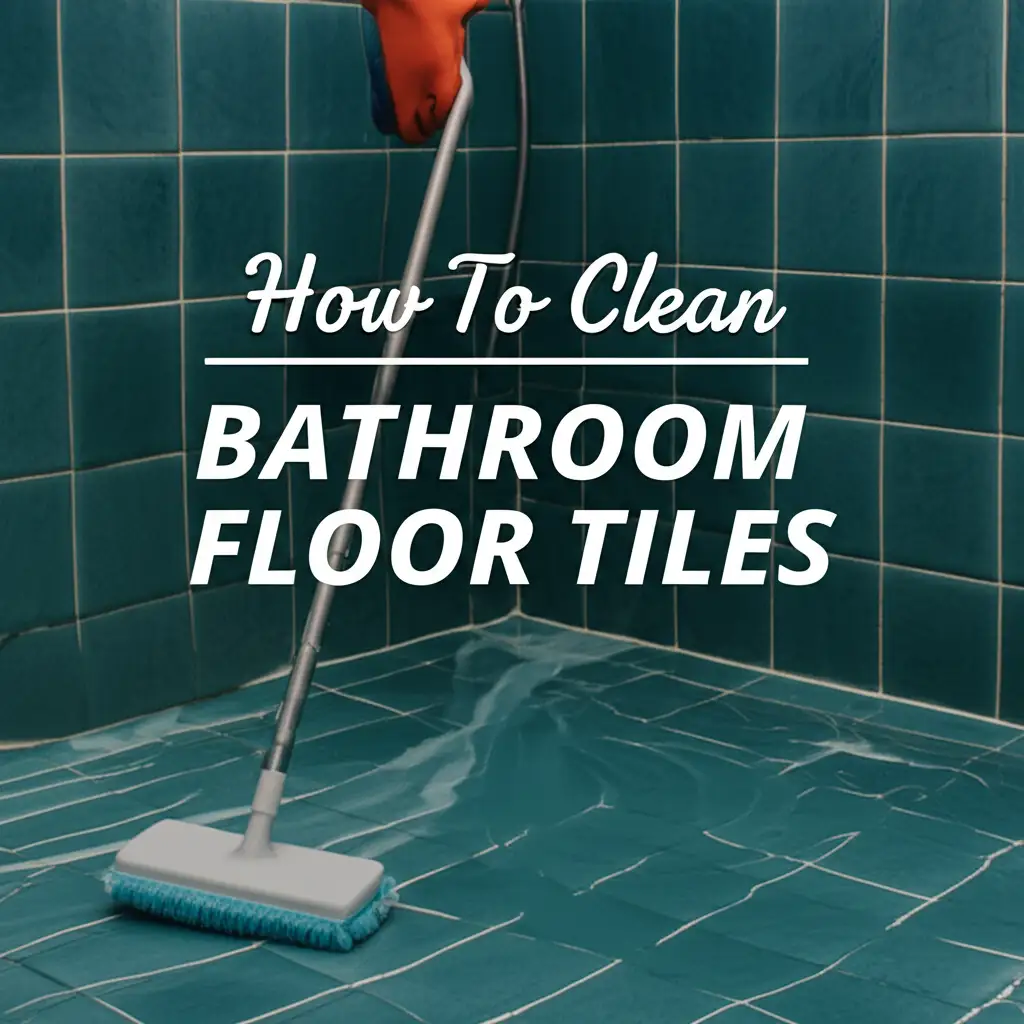· Shower Cleaning · 18 min read
How To Clean Pebble Shower Floor

Clean Your Pebble Shower Floor with Confidence
Do you love the natural beauty of your pebble shower floor but dread cleaning it? Pebble surfaces add unique texture and a spa-like feel to any bathroom. However, their uneven surfaces and numerous grout lines make them challenging to keep clean. Soap scum, mold, and hard water stains love to hide in these crevices.
Learning how to clean pebble shower floor properly helps keep it looking great. I know many homeowners struggle with this exact problem. This article helps you understand the right tools, cleaning solutions, and techniques. We cover daily care, deep cleaning methods, and protective measures. By the end, you will feel ready to tackle any pebble shower floor cleaning task.
Takeaway:
- Regular, light cleaning prevents heavy buildup on pebble shower floors.
- Natural solutions like vinegar and baking soda effectively clean most stains.
- Deep cleaning targets mold, mildew, and stubborn soap scum.
- Sealing the floor protects it from future issues and makes cleaning easier.
- Proper ventilation and drying routines reduce moisture-related problems.
To clean a pebble shower floor, first clear the area and rinse it with warm water. Then, apply a suitable cleaner, such as a baking soda paste or a diluted vinegar solution, allowing it to sit for 10-15 minutes. Use a soft brush or cloth to gently scrub the pebbles and grout, removing dirt and buildup. Rinse thoroughly and dry the surface to prevent water spots and mildew.
Understanding Your Pebble Shower Floor’s Unique Needs
Pebble shower floors bring a distinct aesthetic to your bathroom. They consist of many small stones set in grout. This design creates a beautiful, natural, and slip-resistant surface. However, this natural design also presents unique cleaning challenges.
The textured surface and many grout lines provide more places for dirt to collect. Soap scum, body oils, and mineral deposits cling to the pebbles. Mold and mildew thrive in the damp, warm environment of a shower, especially in unsealed grout. Traditional flat tile floors do not have these same issues. Understanding these factors helps you choose the correct cleaning approach. We want to clean thoroughly without harming the natural stone or the grout.
Why Pebble Floors Get Dirty Faster
Pebble floors have a larger surface area compared to smooth tiles. Each pebble and every line of grout acts as a tiny trap for grime. Soap scum, a mix of body oils and hard water minerals, sticks easily to these rough surfaces. Water does not drain as smoothly as it does on a flat surface, leaving moisture to linger. This moisture promotes the growth of mold and mildew.
The grout lines between pebbles are particularly vulnerable. Grout is porous, meaning it can absorb moisture and dirt. If the grout is not sealed, it quickly becomes discolored and attracts mildew. Regular cleaning prevents these issues from becoming severe. It keeps your pebble floor looking fresh and clean.
Gathering Your Essential Cleaning Tools and Supplies
Before you start cleaning your pebble shower floor, gather all necessary tools and supplies. Having everything ready makes the cleaning process efficient. You want to choose tools that effectively clean the rough surface without causing damage. Harsh scrubbers or abrasive cleaners can scratch pebbles or erode grout.
I always recommend starting with gentle options. You can increase the strength of your cleaner if needed. Protecting your hands and eyes is also important. Some cleaning solutions may irritate skin or eyes. Prepare your cleaning station before you begin.
Must-Have Items for Pebble Shower Cleaning
Here is a list of items you will need:
- Soft-bristle brush: A standard household brush with soft nylon bristles works well for scrubbing pebbles. It cleans without scratching.
- Old toothbrush or grout brush: These tools are essential for cleaning narrow grout lines. They reach into tight spaces between pebbles. For deeper grout cleaning insights, you can read how to clean grout in shower.
- Spray bottle: A spray bottle allows you to apply cleaning solutions evenly. This ensures full coverage over the pebble surface.
- Microfiber cloths or old towels: These are good for wiping surfaces and drying the floor. They absorb water well and leave no lint.
- Bucket: Use a bucket for mixing cleaning solutions and holding rinse water.
- Rubber gloves: Protect your hands from cleaning agents.
- Eye protection: Goggles or safety glasses protect your eyes from splashes.
Recommended Cleaning Solutions
Choosing the right cleaning solution is crucial for pebble floors. Many natural stone cleaners are safe for pebbles and grout. You can also use common household items.
- White vinegar: A natural disinfectant and powerful cleaner for soap scum and hard water stains. Dilute it with water for regular use. For more tips on using vinegar, see how to clean shower with vinegar.
- Baking soda: A mild abrasive that helps lift dirt and odors. It is excellent for making a paste for stubborn stains. Find out more about its uses in how to clean shower with baking soda.
- Mild dish soap: Gentle and effective for general cleaning. Mix a few drops with warm water.
- Hydrogen peroxide: Effective for mildew and light stains. Use it in a spray bottle.
- Commercial stone cleaner: Choose a pH-neutral cleaner specifically designed for natural stone. Read labels carefully to ensure it is safe for your pebble type.
- Grout cleaner (oxygen-based): For tough grout stains. Avoid acid-based cleaners on natural stone.
Always test any cleaner in an inconspicuous area first. This ensures it does not damage your specific pebble or grout.
Daily Care: Keeping Your Pebble Shower Pristine
Regular daily care prevents grime buildup on your pebble shower floor. Small, consistent efforts make a huge difference. You do not want to let dirt and soap scum accumulate. Daily maintenance saves you from difficult deep cleaning jobs later. This routine takes only a few minutes but extends the life and beauty of your pebble surface.
I find that a quick clean after each use is the most effective strategy. It stops moisture from lingering and prevents the growth of mold and mildew. This proactive approach keeps your shower floor looking its best.
Simple Steps for Everyday Cleanliness
Follow these steps daily or after each shower:
- Rinse thoroughly: After showering, rinse the entire pebble floor with warm water. Use the showerhead to wash away soap residue and hair. Make sure water reaches all the crevices between pebbles.
- Squeegee or wipe down: Use a squeegee on the entire pebble surface, or use a clean cloth. This removes excess water. Removing water helps prevent hard water spots and reduces drying time.
- Ensure ventilation: Leave the shower door or curtain open after use. Turn on your bathroom exhaust fan. Good air circulation helps the floor dry completely. This is crucial for preventing mold and mildew growth. Airflow also helps dry the entire bottom of shower area.
- Spray with daily cleaner (optional): Mix equal parts water and white vinegar in a spray bottle. Lightly mist the pebble floor daily. This simple solution acts as a mild disinfectant and helps dissolve soap scum. You do not need to scrub or rinse this daily spray.
These simple habits make a big impact. They protect your beautiful pebble shower floor from common problems.
Deep Cleaning Techniques for Stubborn Stains
Even with daily care, pebble shower floors sometimes need a deep clean. Stubborn stains like heavy soap scum, hard water deposits, and mineral buildup can occur. These issues make your floor look dull and dirty. Deep cleaning helps restore its original luster. I recommend deep cleaning your pebble shower floor once a month or as needed.
When deep cleaning, you need a more powerful approach than daily rinsing. However, you must still be careful. Use effective solutions but avoid harsh chemicals that might damage the natural stone or grout.
Tackling Hard Water Stains and Soap Scum
Hard water leaves behind mineral deposits, creating white or cloudy patches. Soap scum, a combination of soap residue and minerals, forms a sticky, greasy film. Here is how to remove them:
- Prepare the area: Remove any items from the shower floor. Rinse the floor with warm water to loosen surface dirt.
- Apply a vinegar solution: Mix equal parts white vinegar and warm water in a spray bottle. Spray the entire pebble floor generously. Ensure all affected areas are saturated.
- Let it sit: Allow the vinegar solution to sit on the surface for 15-30 minutes. For very tough stains, you can let it sit for an hour. Vinegar needs time to break down minerals and soap scum.
- Scrub gently: Use a soft-bristle brush to scrub the pebbles and grout. Pay extra attention to stained areas. The vinegar will have softened the deposits, making them easier to remove.
- Rinse thoroughly: Rinse the floor with clean, warm water. Make sure all cleaning solution and loosened grime wash away. You might need to rinse several times.
- Repeat if necessary: For extremely stubborn stains, you might need to repeat the process. Alternatively, try a baking soda paste as described next.
Using Baking Soda for Extra Cleaning Power
Baking soda is a mild abrasive and a natural deodorizer. It works well on tough stains that vinegar alone cannot handle.
- Make a paste: Mix baking soda with a small amount of water to create a thick paste. The consistency should be like toothpaste.
- Apply to stains: Apply the paste directly to the stubborn stains, soap scum, or discolored areas.
- Let it sit: Let the paste sit for 30 minutes to an hour. For very deep stains, you can leave it longer.
- Scrub: Use a soft-bristle brush or an old toothbrush to scrub the paste into the pebbles and grout. The baking soda acts as a gentle scrubber, lifting the grime.
- Rinse completely: Rinse the entire floor thoroughly with warm water. Ensure no baking soda residue remains.
For more generalized stubborn dirt on the shower floor, you can adapt these methods. Remember that cleaning the bottom of shower also means targeting specific types of stains on various materials.
Tackling Mold and Mildew on Pebble Surfaces
Mold and mildew are common issues in showers. They thrive in damp, warm environments, especially on porous surfaces like grout. On pebble shower floors, mold and mildew can appear as black, green, or pinkish discoloration. They not only look unsightly but can also cause health problems. Addressing mold and mildew promptly is important.
I always recommend wearing gloves and ensuring good ventilation when dealing with mold. This protects your health. You can use natural solutions or specialized cleaners, depending on the severity. For a broader understanding of how to manage these issues, explore how to clean mold in shower.
Natural Solutions for Mold and Mildew
For minor mold and mildew, natural options are often effective:
Vinegar solution: Undiluted white vinegar is an excellent natural fungicide.
- Spray: Pour undiluted white vinegar into a spray bottle.
- Saturate: Spray the moldy areas of the pebble floor until completely saturated.
- Sit: Let the vinegar sit for at least 30 minutes, or longer for severe mold.
- Scrub: Use a soft-bristle brush to scrub the affected areas.
- Rinse: Rinse the floor thoroughly with warm water.
- Repeat: Repeat the process if mold remains.
Hydrogen peroxide: A powerful, non-toxic alternative to bleach.
- Pour or spray: Apply 3% hydrogen peroxide directly onto the moldy areas.
- Wait: Let it sit for 10-15 minutes. Hydrogen peroxide bubbles as it breaks down mold.
- Scrub: Scrub the areas with a brush.
- Rinse: Rinse the floor well with water.
When to Consider Stronger Cleaners (Use with Caution)
For very heavy mold or mildew that natural solutions cannot remove, you might consider stronger options. However, use these with extreme caution, especially on natural stone. Always test in an inconspicuous area first.
- Oxygen bleach (powdered cleaner): This is a safer alternative to chlorine bleach for grout and some stones. Mix it with water according to package directions to form a paste. Apply it to the moldy grout and let it sit for a few hours or overnight. Scrub and rinse thoroughly. Always ensure good ventilation.
- Chlorine bleach (very diluted and rarely recommended): I rarely recommend chlorine bleach for natural stone or colored grout. It can discolor grout and etch stone. If you must use it, dilute it heavily (1 part bleach to 10 parts water). Apply it only to the grout lines with a cotton swab or small brush. Let it sit for a few minutes ONLY. Rinse immediately and thoroughly. Ensure excellent ventilation. Refer to how to clean shower with bleach for more details if you choose this method.
Always ventilate the bathroom well during and after cleaning. Use gloves and eye protection. Proper drying after cleaning is vital to prevent mold from returning.
Restoring Grout Lines in Your Pebble Shower
Grout lines are the most vulnerable part of a pebble shower floor. They are porous and absorb water, soap, and dirt easily. Over time, grout can become discolored, stained, or even harbor mold and mildew. Clean, bright grout makes the entire pebble floor look new. Neglected grout can make your shower look perpetually dirty.
Restoring grout lines is a key part of deep cleaning your pebble shower floor. It requires specific tools and dedicated effort. I find focusing on the grout transforms the overall appearance.
Effective Methods for Grout Restoration
Baking Soda Paste for Light Stains:
- Mix: Combine baking soda with water to make a thick paste.
- Apply: Spread the paste generously over the grout lines.
- Spray: Lightly spray the baking soda paste with white vinegar. This creates a fizzing action that helps lift dirt.
- Wait: Let the mixture sit for 10-15 minutes.
- Scrub: Use an old toothbrush or a small grout brush to scrub the grout lines. The small bristles reach deep into the texture.
- Rinse: Rinse the entire floor thoroughly with warm water, making sure to remove all paste and loosened grime.
Hydrogen Peroxide for Deeper Discoloration:
- Apply: Pour or spray 3% hydrogen peroxide directly onto the grout lines.
- Sit: Allow it to sit for at least 15 minutes. You might see some bubbling, which means it is working.
- Scrub: Use a grout brush or toothbrush to scrub the discolored areas.
- Rinse: Rinse the floor completely with clean water.
Commercial Grout Cleaner (Oxygen-based):
- Select: Choose a commercial grout cleaner that is safe for natural stone and is oxygen-based. Avoid acid-based cleaners, which can damage grout and pebbles.
- Follow directions: Apply the cleaner according to the product’s instructions.
- Scrub: Use a grout brush to work the cleaner into the grout.
- Rinse: Rinse thoroughly to remove all cleaner residue.
Remember that you can also explore techniques on how to clean floor grout without scrubbing if you prefer less manual effort, although pebble grout often requires some scrubbing due to its texture. Regular cleaning helps prevent grout from getting very dirty. Sealing your grout after cleaning protects it further, which we will cover next.
Sealing Your Pebble Shower Floor for Protection
After you have thoroughly cleaned your pebble shower floor, the next important step is sealing. Sealing provides a protective barrier over the pebbles and, more importantly, the grout. Grout is porous, meaning it has tiny holes that can absorb water, dirt, soap scum, and mold. An unsealed or poorly sealed floor is much harder to keep clean.
I consider sealing a critical part of maintaining your pebble shower floor. It makes future cleaning easier and prevents stains and mold from penetrating the surface. It also extends the life of your beautiful floor.
Why Sealing is Crucial for Pebble Floors
- Prevents water absorption: A good sealant repels water. This prevents moisture from seeping into the grout lines, which reduces the risk of mold and mildew growth.
- Resists stains: Stains from soap scum, hard water, and body oils sit on the surface of a sealed floor. This makes them much easier to wipe away.
- Protects grout: Sealing protects grout from discoloration and erosion. It keeps the grout looking cleaner for longer.
- Extends life: By protecting against water damage and staining, sealing helps your pebble floor last longer.
How to Seal Your Pebble Shower Floor
Sealing is not a difficult process, but it requires patience and proper application.
- Ensure cleanliness: The floor must be completely clean and dry before sealing. Any trapped dirt or moisture will be sealed in. Allow at least 24-48 hours for the floor to dry fully after cleaning. Good ventilation helps.
- Choose the right sealant: Select a penetrating sealer designed for natural stone and grout. These sealers penetrate below the surface, offering better protection. Look for products that are water-based and non-toxic. Read the product label carefully for specific instructions and compatibility with your pebble type.
- Apply the sealant:
- Ventilate: Ensure the bathroom is well-ventilated.
- Gloves: Wear rubber gloves.
- Test: Test the sealer in an inconspicuous area first to check for any adverse reactions or changes in appearance.
- Apply evenly: Use a paint roller with a short nap, a foam brush, or a clean cloth to apply the sealer evenly over the entire pebble floor. Ensure you saturate the grout lines well.
- Wipe excess: After 5-15 minutes (check product instructions), use a clean, dry cloth to wipe away any excess sealer from the surface of the pebbles. Do not let it dry on top, as it can leave a hazy residue.
- Second coat: Many sealers recommend a second coat after a specific drying time (usually 1-3 hours). This provides extra protection. Repeat the application and wipe-off process.
- Cure time: Allow the sealant to cure completely before using the shower. This can take 24-72 hours, depending on the product and humidity. Follow the manufacturer’s guidelines strictly.
How Often to Reseal
The frequency of resealing depends on the type of sealer you use and how often your shower is used. Generally, I recommend resealing your pebble shower floor every 1-3 years. You can perform a simple water test to check if your sealer is still effective: drop a few beads of water onto the dry floor. If the water beads up, the sealer is still working. If it soaks in, it is time to reseal.
Maintaining a Pristine Pebble Shower: Long-Term Tips
Keeping your pebble shower floor in top condition requires ongoing effort beyond just cleaning and sealing. A few simple habits and considerations can greatly extend the beauty and longevity of your unique floor. I always tell my clients that prevention is easier than cure. These tips help you prevent common problems and reduce the need for aggressive cleaning.
Best Practices for Continued Care
- Use pH-neutral cleaners: Avoid harsh, acidic, or abrasive cleaners on a daily basis. These can strip the sealer, etch the pebbles, or damage the grout. Stick to pH-neutral or mild natural cleaners for routine cleaning.
- Avoid harsh scrubbing tools: While a soft-bristle brush is fine, avoid steel wool, scouring pads, or stiff-bristle brushes. These can scratch the pebbles or wear down the grout.
- Install a water softener: If you have very hard water, a water softener system can significantly reduce mineral buildup on your shower floor and fixtures. This lessens hard water stains.
- Control humidity: Use an exhaust fan during and after showers. Consider a dehumidifier in very humid climates. Good air circulation prevents moisture buildup, which is a prime cause of mold and mildew.
- Address issues quickly: Do not let stains or mold sit. The faster you clean them, the easier they are to remove. A small patch of mold can quickly grow into a larger problem if ignored.
- Regular inspection: Periodically inspect your grout and pebbles for signs of wear, cracking, or unusual discoloration. Early detection helps you address problems before they become major repairs.
By integrating these long-term maintenance tips into your routine, your pebble shower floor will remain a beautiful and unique feature in your home. It ensures you enjoy its natural aesthetic without the constant worry of difficult cleaning.
FAQ Section
How often should I clean my pebble shower floor?
You should rinse your pebble shower floor daily after each use. Perform a light cleaning with a mild spray solution once or twice a week. A deep cleaning, targeting soap scum, hard water, and grout issues, is recommended once a month or every two months, depending on use and water hardness.
Can I use bleach on my pebble shower floor?
I generally do not recommend using bleach on pebble shower floors, especially on natural stone pebbles or colored grout. Bleach can cause discoloration, etching, or damage to the sealer. For mold or mildew, try natural alternatives like vinegar or hydrogen peroxide first. If bleach is absolutely necessary for severe mold, use a highly diluted solution and rinse immediately.
How do I prevent mold on my pebble shower?
Preventing mold involves controlling moisture. Always use an exhaust fan during and after showers for at least 30 minutes. Leave the shower door or curtain open to promote airflow. Wipe down the floor with a squeegee or towel after each use. Ensure your grout is properly sealed, and re-seal it every 1-3 years.
What’s the best cleaner for pebble shower grout?
For pebble shower grout, a paste of baking soda and water, or a spray of undiluted white vinegar, works well for most stains and light mold. For tougher issues, an oxygen-based commercial grout cleaner is effective and safer than acid-based cleaners on natural stone. Always use a small grout brush for scrubbing.
Do pebble shower floors need sealing?
Yes, absolutely. Pebble shower floors require sealing. The grout between the pebbles is porous and absorbs water, soap, and dirt, leading to stains and mold. Sealing creates a protective barrier that repels water and stains. It makes the floor easier to clean and significantly extends its lifespan.
Conclusion
Cleaning your pebble shower floor might seem like a daunting task, but it is manageable with the right approach. We have explored everything from daily maintenance routines to deep cleaning techniques for stubborn issues like mold, soap scum, and hard water. Understanding the unique characteristics of your pebble floor and choosing appropriate, gentle yet effective cleaning solutions makes all the difference.
By implementing the simple steps for regular care and tackling deeper cleaning when needed, your pebble shower floor will retain its natural beauty. Remember to prioritize proper ventilation and consider sealing your floor for long-term protection. Investing time in routine care ensures your “How To Clean Pebble Shower Floor” challenges turn into satisfying achievements. With these tips, you will keep your pebble shower a clean, beautiful, and inviting part of your home for years to come.
- pebble shower
- shower floor cleaning
- grout cleaning
- mold removal
- shower maintenance




